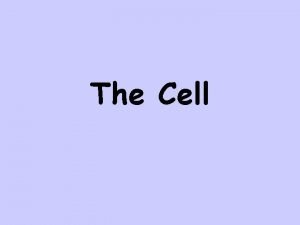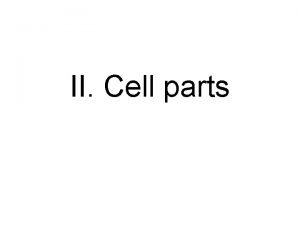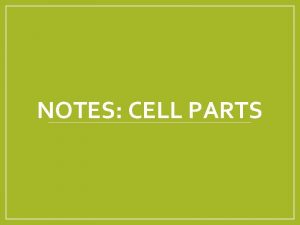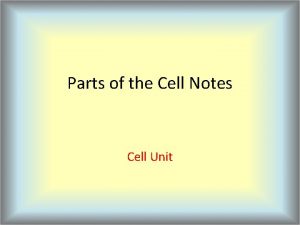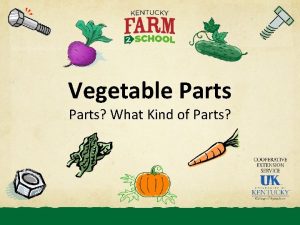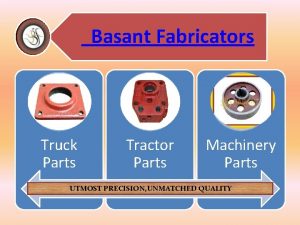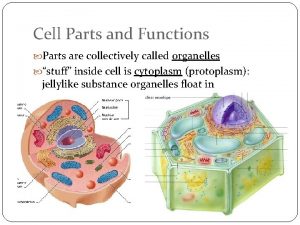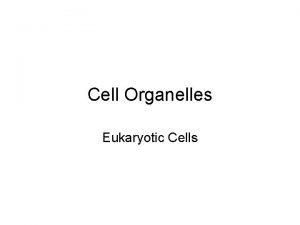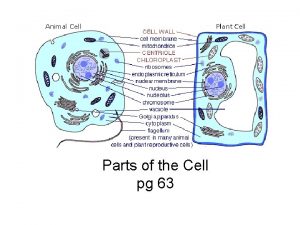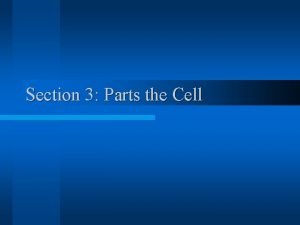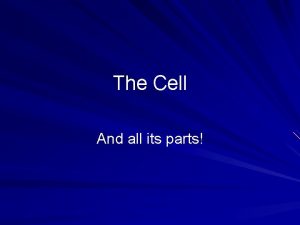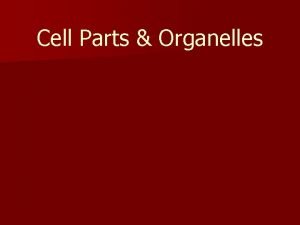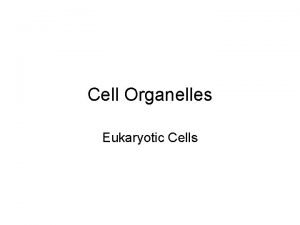Parts of the Cell K 01 Parts of

























- Slides: 25

Parts of the Cell…

K 01: Parts of the Cell • CYTOPLASM – liquid “soup” within a cell • CELL WALL – tough outer covering of plant cell • CELL MEMBRANE – outer layer of animal cell • ENDOPLASMIC RETICULUM – transports substances around the cell • GOLGI BODIES – used to process and modify proteins to ready them for export • VACUOLES and VESICLES– storage in cells

K 01: Parts of the Cell • RIBOSOMES – for protein synthesis • MITOCHONDRIA – provides cell energy • CHLOROPLASTS – convert light energy to chemical energy in plants • LYSOSOMES – digestive “stomach” of cells • CENTRIOLES– used in animal cell division • NUCLEUS– “brain” of cell; contains DNA

K 01: Parts of the Cell

Cell Membrane…

K 02: Cell Membrane The cell membrane is a P H O S P H O L I P I D PHOSPHOLIPID BILAYER Hydrophilic Phosphate Head Only 2 Fatty acids attached to the glycerol. These are HYDROPHOBIC

K 02: Cell Membrane The cell membrane is a PHOSPHOLIPID BILAYER Since the cell is in water naturally, two layers form with the fatty acids toward the inside (away from water)

K 02: Cell Membrane There will also be proteins embedded in the membrane to allow for movement of materials across the membrane

Plant vs. Animal…

K 05: Plant vs. Animal Cell Plant cell • has cell wall and membrane • one large vacuole • has chloroplasts • no centrioles Animal cell • has only cell membrane • many small vesicles • no chloroplasts • centrioles for cell division

Cell Theory…

K 06: Cell Theory States: • All living things are composed of cells. • The cell is the basic unit of life • All cells come from other cells • Cells can not come from nonliving things

Cell Size…

K 07: Cell Size As a cell grows its volume increases ten times faster than its surface area. Cell Dimension Small (1 cm) Large (10 cm) Surface Area Volume SA/V 6 cm 2 1 cm 3 6 x 600 cm 2 1000 cm 3 0. 6 x

K 07: Cell Size The cell receives all nutrients and gets rid of waste through its membrane (surface). As volume increases, the surface can’t exchange materials efficiently and wastes build up inside while not enough nutrients get in from outside.

Movement of Materials…

K 08: Movement of Materials • DIFFUSION – substances moving from an area of high concentration to an area of low concentration • OSMOSIS – diffusion of water animation Concentration gradient is when there is concentration difference between places

K 08: Movement of Materials • HYPERTONIC – a solution has MORE solute (salt) than the cell. • HYPOTONIC – a solution has LESS solute than the cell. • ISOTONIC – a solution has the SAME solute concentration as the cell.

K 08: Movement of Materials • FACILITATED DIFFUSION – substances move across a membrane through protein ports animation • ACTIVE TRANSPORT – cellular energy is required to move substances from LOW to HIGH concentration (against the concentration gradient) • ENDOCYTOSIS – cells engulf large particles…. this requires energy animation • EXOCYTOSIS – cells expel large particles …. this requires energy

Patterns of Organization…

K 09: Levels of Organization Muscle Cells CELLS Muscle Tissue TISSUES ORGANS SYSTEMS Heart Circulatory System

Basic Tissues…

K 10: Basic Tissues • MUSCLE TISSUE – for movement in the body. Ex. Skeletal muscle, cardiac muscle • EPITHELIAL TISSUE – forms the coverings of organisms and organs. Ex. Skin, stomach lining • CONNECTIVE TISSUE – connects and supports the body structure Ex. Bones, fat, blood • NERVOUS TISSUE – used for transmitting and storing messages within the body. Ex. Brain, senses

Cell movie • Cell movie

Tomorrow • Last day to hand in labs/assignments!!! • Biochemistry Unit Exam – Study notes/labs – Review Text p. 278 Q#1, 3 -5, 10, 12 -14
 Hình ảnh bộ gõ cơ thể búng tay
Hình ảnh bộ gõ cơ thể búng tay Bổ thể
Bổ thể Tỉ lệ cơ thể trẻ em
Tỉ lệ cơ thể trẻ em Chó sói
Chó sói Tư thế worm breton
Tư thế worm breton Chúa yêu trần thế
Chúa yêu trần thế Môn thể thao bắt đầu bằng từ chạy
Môn thể thao bắt đầu bằng từ chạy Thế nào là hệ số cao nhất
Thế nào là hệ số cao nhất Các châu lục và đại dương trên thế giới
Các châu lục và đại dương trên thế giới Công thức tính độ biến thiên đông lượng
Công thức tính độ biến thiên đông lượng Trời xanh đây là của chúng ta thể thơ
Trời xanh đây là của chúng ta thể thơ Mật thư tọa độ 5x5
Mật thư tọa độ 5x5 Làm thế nào để 102-1=99
Làm thế nào để 102-1=99 Phản ứng thế ankan
Phản ứng thế ankan Các châu lục và đại dương trên thế giới
Các châu lục và đại dương trên thế giới Thể thơ truyền thống
Thể thơ truyền thống Quá trình desamine hóa có thể tạo ra
Quá trình desamine hóa có thể tạo ra Một số thể thơ truyền thống
Một số thể thơ truyền thống Cái miệng xinh xinh thế chỉ nói điều hay thôi
Cái miệng xinh xinh thế chỉ nói điều hay thôi Vẽ hình chiếu vuông góc của vật thể sau
Vẽ hình chiếu vuông góc của vật thể sau Nguyên nhân của sự mỏi cơ sinh 8
Nguyên nhân của sự mỏi cơ sinh 8 đặc điểm cơ thể của người tối cổ
đặc điểm cơ thể của người tối cổ Thế nào là giọng cùng tên
Thế nào là giọng cùng tên Vẽ hình chiếu đứng bằng cạnh của vật thể
Vẽ hình chiếu đứng bằng cạnh của vật thể Tia chieu sa te
Tia chieu sa te

























